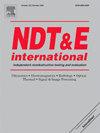Laser-EMAT ultrasonic resonance detection and high-resolution imaging of thinning damage in high-temperature thin-walled alloys
IF 4.5
2区 材料科学
Q1 MATERIALS SCIENCE, CHARACTERIZATION & TESTING
引用次数: 0
Abstract
Aero-engine hot-section components are prone to damage forms such as corrosion thinning, creep, and fatigue under complex stress fields and high-speed airflow erosion environments. There is an urgent need to develop a monitoring method suitable for high temperatures and vibrations in extreme operating conditions to enable online inspection of damage in high-temperature alloy components. Therefore, this study proposes a Laser-EMAT ultrasonic shear wave resonance method with large lift-off and high-temperature detection capabilities. It achieves rapid online detection of thinning defects in 800 °C high-temperature thin-walled alloy materials at a lift-off of 5 mm, with a maximum detection error not exceeding 6.07 %. Furthermore, through ultrasonic amplitude-frequency domain multi-feature fusion rapid imaging, high-resolution detection of thin-walled alloys with spherical corrosion thinning defects featuring varying cross-sections and curvature was achieved. The proposed method overcomes key challenges of traditional electromagnetic acoustic resonance (EMAR) detection, such as small lift-off, low energy conversion efficiency, limited high-temperature capability, and the low signal-to-noise ratio of laser ultrasonic detection, particularly its sensitivity to environmental stability. It is expected to be applied in high-temperature online monitoring under complex service conditions.
高温薄壁合金薄化损伤的激光- emat超声共振检测与高分辨率成像
航空发动机热截面部件在复杂应力场和高速气流侵蚀环境下容易出现腐蚀变薄、蠕变、疲劳等损伤形式。迫切需要开发一种适用于极端操作条件下高温和振动的监测方法,以实现高温合金部件损伤的在线检测。因此,本研究提出了一种具有大升力和高温探测能力的激光- emat超声剪切波共振方法。实现了800℃高温薄壁合金材料增薄缺陷5 mm的快速在线检测,最大检测误差不超过6.07%。此外,通过超声幅频域多特征融合快速成像,实现了对具有不同截面和曲率的球形腐蚀变薄缺陷的薄壁合金的高分辨率检测。该方法克服了传统电磁声共振(EMAR)探测的关键挑战,如升空小、能量转换效率低、高温能力有限以及激光超声探测的低信噪比,特别是对环境稳定性的敏感性。有望应用于复杂工况下的高温在线监测。
本文章由计算机程序翻译,如有差异,请以英文原文为准。
求助全文
约1分钟内获得全文
求助全文
来源期刊

Ndt & E International
工程技术-材料科学:表征与测试
CiteScore
7.20
自引率
9.50%
发文量
121
审稿时长
55 days
期刊介绍:
NDT&E international publishes peer-reviewed results of original research and development in all categories of the fields of nondestructive testing and evaluation including ultrasonics, electromagnetics, radiography, optical and thermal methods. In addition to traditional NDE topics, the emerging technology area of inspection of civil structures and materials is also emphasized. The journal publishes original papers on research and development of new inspection techniques and methods, as well as on novel and innovative applications of established methods. Papers on NDE sensors and their applications both for inspection and process control, as well as papers describing novel NDE systems for structural health monitoring and their performance in industrial settings are also considered. Other regular features include international news, new equipment and a calendar of forthcoming worldwide meetings. This journal is listed in Current Contents.
 求助内容:
求助内容: 应助结果提醒方式:
应助结果提醒方式:


